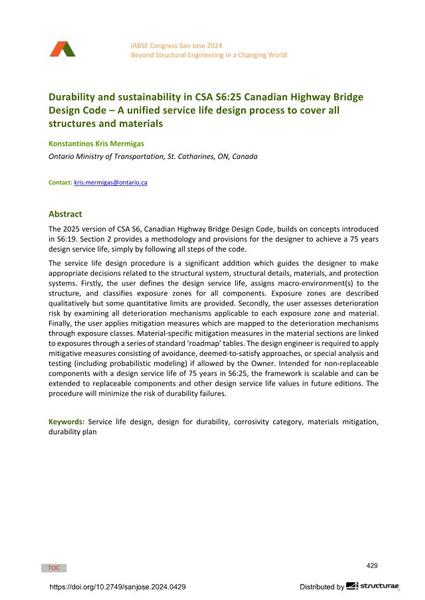Durability and sustainability in CSA S6:25 Canadian Highway Bridge Design Code – A unified service life design process to cover all structures and materials

|
|
|||||||||||
Détails bibliographiques
| Auteur(s): |
Konstantinos Kris Mermigas
(Ontario Ministry of Transportation, St. Catharines, ON, Canada)
|
||||
|---|---|---|---|---|---|
| Médium: | papier de conférence | ||||
| Langue(s): | anglais | ||||
| Conférence: | IABSE Congress: Beyond Structural Engineering in a Changing World, San José, Cost Rica, 25-27 Seotember 2024 | ||||
| Publié dans: | IABSE Congress San José 2024 | ||||
|
|||||
| Page(s): | 429-437 | ||||
| Nombre total de pages (du PDF): | 9 | ||||
| DOI: | 10.2749/sanjose.2024.0429 | ||||
| Abstrait: |
The 2025 version of CSA S6, Canadian Highway Bridge Design Code, builds on concepts introduced in S6:19. Section 2 provides a methodology and provisions for the designer to achieve a 75 years design service life, simply by following all steps of the code. The service life design procedure is a significant addition which guides the designer to make appropriate decisions related to the structural system, structural details, materials, and protection systems. Firstly, the user defines the design service life, assigns macro-environment(s) to the structure, and classifies exposure zones for all components. Exposure zones are described qualitatively but some quantitative limits are provided. Secondly, the user assesses deterioration risk by examining all deterioration mechanisms applicable to each exposure zone and material. Finally, the user applies mitigation measures which are mapped to the deterioration mechanisms through exposure classes. Material-specific mitigation measures in the material sections are linked to exposures through a series of standard ‘roadmap’ tables. The design engineer is required to apply mitigative measures consisting of avoidance, deemed-to-satisfy approaches, or special analysis and testing (including probabilistic modeling) if allowed by the Owner. Intended for non-replaceable components with a design service life of 75 years in S6:25, the framework is scalable and can be extended to replaceable components and other design service life values in future editions. The procedure will minimize the risk of durability failures. |
||||
